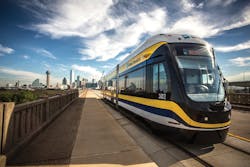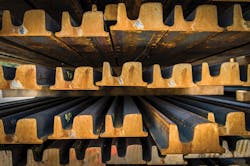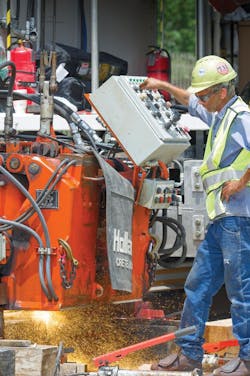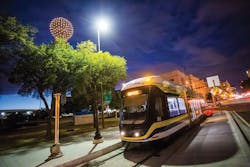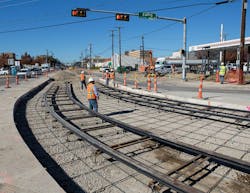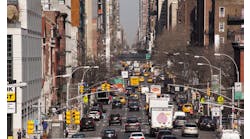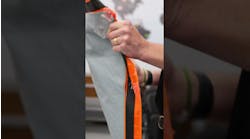By: John Quintero
Sprouting almost overnight, the Dallas-Oak Cliff community, whose name comes from the massive oaks crowning the soft green rolling cliffs of the Trinity River, was one of the greatest U.S. suburban developments during the early 1900s.
It boasted an opera house, a 44-acre theme park, two major league baseball teams and a university—all connected via a steam-powered rapid transit railway system with canopy-covered stations every two blocks. The Oak Cliff community was built on the idea of walkable and mixed-use neighborhoods.
In May 1908, a 50-ft rise in the Trinity River destroyed or inundated all river crossings from Oak Cliff to Dallas. Despite the hefty $600,000 cost, the city of Dallas and Oak Cliff residents approved the construction of the Houston Street Viaduct to be the first “permanent” crossing of the Trinity River. At the time of its construction, it was said to be the longest reinforced concrete viaduct in the world.
On Jan. 14, 1956, much to local residents’ dismay, the last streetcar ran from downtown Dallas to Oak Cliff. For nearly 70 years, streetcars had run through the Oak Cliff boulevards. Over time, these twisting and turning rail lines were paved over, and the once familiar sound of the streetcar bell ceased.
The 1950s and 1960s were a stormy and dark time in Oak Cliff history. In 1957, a massive tornado devastated many of Oak Cliff’s historic homes. A dark cloud fell over the city of Dallas and Oak Cliff in particular with President John F. Kennedy’s assassination on Nov. 22, 1963. It was on this date that Dallas police officers converged on Oak Cliff’s beautiful Texas Theatre searching for a man who had entered without paying. That man was Lee Harvey Oswald. Oak Cliff rocketed into the international spotlight in a most unfavorable manner that solemn day.
During this harsh economic period, many businesses closed, home values plummeted and homes were converted to multi-unit apartments. The community boulevards and neighborhoods lost much of their former charm and beauty.
Bringing it back
In the 1980s and 1990s, new life grew in the area when urban pioneers began buying up the large dilapidated frame houses. The Bishop Arts District and Oak Cliff redevelopment influenced artists, musicians and young professionals to reside again in the area. A new era dawned for this community.
A stack of 112TRAM block rail ready to go (Keith Philpott, HDR).
In 2010, a local nonprofit organization, the Oak Cliff Transit Authority, spearheaded the city’s effort to obtain from the U.S. DOT a $23 million Transportation Investment Generating Economic Recovery (TIGER) grant to reintroduce a modern streetcar system in Oak Cliff. The grant application centered on the theme “Regional Connections—Linking Livability.” The idea of integrating housing, employment and rail transit through the linkage of the Dallas central business district with the walkable, mixed-use neighborhoods of Oak Cliff allowed this project to stand out among the other 17,000 TIGER grant applicants.
Flash butt welding of 112TRAM block rail at the Dallas Streetcar site. (Keith Philpott, HDR).
In 2010, Dallas Area Rapid Transit (DART) selected the Stacy and Witbeck/Carcon Industries (SW/C) team, with lead designer HDR, to design and build the $56.5 million streetcar line. Although only 1.6 miles in length, it is the multi-million-dollar streetcar system’s most important and costly segment, providing the critical crossing over the Trinity River floodplain separating downtown Dallas from Oak Cliff.
The single-track, bi-directional streetcar alignment required constructing cast-in-place concrete trackslab along the Houston Street Viaduct. The viaduct has been a key landmark for more than 104 years; it is listed on the U. S. Register of Historic Places and recognized as a historical civil engineering landmark by the American Society of Civil Engineers.
The bridge’s 44-ft-wide deck was originally designed to accommodate two streetcar rails serving downtown Dallas and Oak Cliff. The rails were never laid. The mile-long structure required extensive rehabilitation because of its advanced age and extensive concrete deterioration both aesthetically and structurally. The SW/C design-build team performed a comprehensive inspection to identify necessary repairs and convey proposed rehabilitation strategies to the State Historic Preservation Officer (SHPO). Strengthening the 104-year-old structure required the team to perform in-depth, 3-D finite-element analyses to verify the viaduct’s load-rating capacity. This 3-D modeling was based on unlikely sources: the original 1910 design drawings obtained from the city of Dallas vault and a 1911 “Engineering–Contracting” article containing detailed design information, which was discovered through extensive research of historical documents.
Establishing design criteria
DART is the largest light rail owner and operator in the U.S.; as such, its rail standards were developed specifically for light rail transit (LRT) systems, which vary substantially from streetcar systems. The design team helped DART appreciate the engineering and construction differences between a light rail system and modern streetcars. The team proposed incorporating the embedded track guidelines from the 2012 American Railway Engineering and Maintenance-of-Way Association (AREMA) manual to better serve the Dallas Streetcar design and construction. These guidelines allowed the streetcar vehicle to negotiate tighter curve radii found in neighborhood roadways. The improved turn radius reduced the reconstruction limits of existing roadway pavement and associated utility infrastructure rework, minimizing construction impacts on local businesses and residents.
By exhibiting the reduced impacts, the team obtained a design exception to current track alignment criteria from DART and replaced it with the suggested 2012 AREMA Embedded Track Guidelines. These guidelines are now the basis for all future Dallas Streetcar expansion programs.
Going off-wire and more
The engineering and materials used in the Dallas Streetcar project represent a major step forward in modern U.S. streetcar design and set the benchmark for future systems.
One of the challenges in modifying an historic structure for streetcar use is the viaduct’s aforementioned status on the U.S. Register of Historical Places. Early coordination with the Texas Historic Commission had precluded the installation of an overhead catenary or trolley wire on the bridge.
To overcome this challenge, a unique partnership was developed between DART, SW/C, HDR and domestic streetcar manufacturer Brookville Equipment Corp. to deliver the first American-made “off-wire” streetcar that operates on battery power. For two-thirds of the 1.6-mile-long track, Brookville’s Liberty Streetcar operates exclusively off an on-board energy storage system which utilizes a redundant lithium ion battery system capable of powering the car when running off-wire.
The off-wire design is beneficial to areas where streetcars cross under bridges, over overpasses or across train tracks, because existing structures or signal arms can interfere with overhead wires. Based on the success of this project, cities (including Detroit) are now looking to implement off-wire segments to work around existing infrastructure, offering the ability to run the track in closer proximity to other tracks and avoid overhead obstacles.
The Dallas Streetcar also incorporates a relatively new rail type, 112TRAM block rail. In fact, it is only the second project in the U.S. to use this rail type, which is used extensively in Europe, and the first to use pre-curved block rail. Designers traveled to Poland to study block rail—the preferred rail type in tram-heavy Europe. They developed specifications to have the materials manufactured in the U.S. to comply with the Buy America requirements of the TIGER Grant program.
Block rail’s shallow profile and steel flangeway makes it ideal for streetcar projects in urban settings. The narrower flangeway makes the tracks less likely to interfere with or cause injury to cyclists and motorists. Designers collaborated with the contractor and DART to improve the durability and constructability of block rail ties, rail clips, boots and isolation joints for the project. Other cities also are taking cues from the block rail use. Projects in Kansas City, Seattle and Milwaukee are already benefiting from the advancements made on the Dallas Streetcar.
In addition to being the first U.S. installation of off-wire capability and pre-curved block rail, Dallas Streetcar marked the first project to use a time-saving flash butt welding technique during construction. Normal construction of embedded track would require thermite welding. However, with close to 300 welds on the job and each thermite weld taking up to four hours for the fit-up and welding process, the SW/C design-build team developed a faster alternative. By using custom-built flash butt welding equipment, they determined that three or four flash welds could be done in an hour. Flash butt welding ultimately allowed the project team to cut the average weld time down from up to four hours to less than 20 minutes. Multiplied across the nearly 300 welds on the project, flash welding is estimated to have saved around 1,100 hours (45 days) of construction time.
At the Union Station stop near Reunion Tower (Mike Cameron, HDR).
Ultimately, it’s about community
Properties along the streetcar alignment are in high demand for redevelopment, and numerous other properties are in transition from brownfields to mixed-use development. No bus line or major road created in the past 30 years in Dallas has triggered as much walkable development as the Dallas Streetcar has spurred in Oak Cliff. Unlike city bus routes, which can be altered at any time, a streetcar line brings permanence and gives confidence to investors to build new businesses and residents along it. Local businesses have embraced the walkable district idea with small businesses, bike lanes, cafe seating and enhanced foot traffic. Other U.S. cities, like Portland, have discovered that private investment follows streetcar development.
Track installation at the intersection of Colorado and Zang (DART).
The Dallas Streetcar officially began operation on April 13, 2015, after almost 10 years of community involvement to restore its lost heritage. Streetcars are back in Dallas and the familiar sound of the streetcar bell that went dormant 60 years ago is now ringing again throughout the Oak Cliff community.
On the Oak Cliff Transit Authority website, project advisor Rick Gustafson, the father of Portland’s streetcar system, is quoted as saying, “You have to get a stake in the ground . . . the first few miles won’t make any sense, but the momentum will build and slowly the network will take shape.”
And he was right. Today, the Dallas Streetcar project is helping the Oak Cliff community place that stake in the ground, providing the most important and costly streetcar elements: two modern “off-wire” streetcars, connection to Union Station, tie-in to DART’s maintenance yard and a viable Trinity River floodplain crossing. The stake will only deepen as Bishop Arts and Dallas Convention Center area stops are completed in 2016 and beyond. Through this project, the Oak Cliff community will restore a small piece of its heritage and return its beautifully sculpted boulevards and neighborhoods to their former grandeur. TM&E
About The Author: Quintero is a professional associate/senior bridge designer with HDR.
